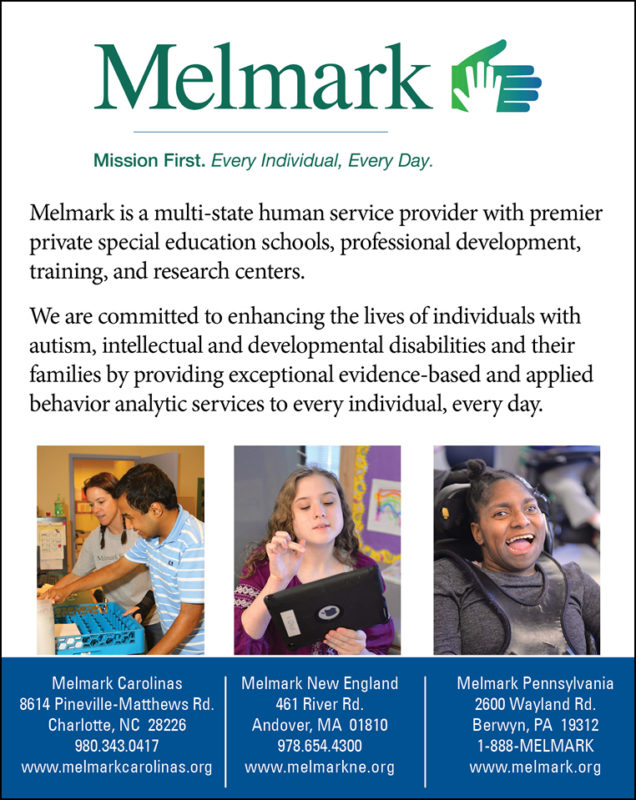The transition for individuals affected by autism from special education services to adult services often poses a great deal of anxiety and barriers for the individual in transition, as well as for their parents, caregivers and service professionals. Under the Individuals with Disabilities Education Act (IDEA, 2004), students are entitled to a range of special education services and the associated funding of those services until they receive a high school diploma or have aged out of the school system (this differs in age from 18 to 21 years old). Once their special education services have concluded, these same services and funding options are no longer available. Therefore, it becomes critical to have appropriate transition services in place while the student is in the school system. These services should provide a strong foundation of acquired daily living skills, employment options, and community participation that will assist the young adult to access a meaningful post-school experience and prepare for the challenges of adulthood.

Helena L. Maguire, MS, LABA, BCBA, Executive Director
Quite often, experts stress to educators and parents the importance of preparing for the transition process early. The transition planning process is conducted collaboratively among the school district, educators, parents and the student. The goal of these transition planning meetings is to ensure that students with autism receive comprehensive transition services as provided under IDEA (2004). It is the school district’s responsibility to provide the needed supports to that student in order to meet his or her goals for after high school to the best of his or her abilities. Given the complexity of the needs of most students with Autism Spectrum Disorder (ASD), appropriate planning is a multi-year process. Through the student’s Individual Education Program (IEP) process, transition planning services must be included for all special education students at age 14. However, as indicated by all the messages to parents and educators to “start early,” it is important to emphasize that the process should begin as early as 12 years old, and can begin even earlier.
As young adults with autism face the challenges of adulthood, they are also presented with many opportunities that can be made available with proper planning, training, and skills development. As a collaborative team, planning for this transition before the critical date is perhaps the key to addressing potential barriers of success. Thinking about what the young adult’s life should include typically involves an evaluation of the following:
- Further vocational education or post-secondary education
- Job-supported employment
- Day habilitation programs
- Community volunteerism
- Recreational interests
- Living arrangements
Deciding upon these goals and then developing the corresponding plans in order to maximize skills instruction becomes the next step. Additionally, at any time in the transition years that it is warranted, these goals should be altered to reflect the best plan for the student as he or she reaches adulthood. It is important that the student develops the necessary skills during the school years that will enable him or her to achieve these goals in his or her adult life.
The incidence increase, as reported by the Centers for Disease Control and Prevention (CDC), in autism rates over the past few years (Baio et al., 2018) has increased awareness and created more opportunities for young adults with autism for post-school life options. Most community colleges have created programs that support students through their college programs. Employers have developed relationships with service providers to support the employment for individuals with varying degrees of specialized disabilities and needs. Through each state’s developmental disabilities service departments, resources are available to assist with employment counseling, on the job training, community activities for recreation, social groups and volunteerism. Accessing this information of available resources and synthesizing the options into a well-planned approach is often one of the challenges for parents and educators.
Understanding as a collaborative team that the eligibility and provisions of special education services are not equivalent to the eligibility and services in the adult sector is critical and requires transparency of those differences early in the collaborative planning process. As increasing numbers of students with ASD age out of special education services across the nation, challenges include funding as well as the sufficiency of service providers with expertise in meeting the range of needs for young adults. As stated by Dr. Peter Gerhardt (Gerhardt, 2009; Gerhardt & Lainer, 2011), “We know there’s a crisis coming. It’s not just a money crisis. It’s a service crisis.”
Part of this service crisis is the infusion of the adult service agency to participate in the planning process currently occurs too late in the process. Typically, representatives from the adult service system do not join the team prior to the student being 18; yet the planning process has begun by age 14 as a formal IEP process. An additional service crisis is that special educators and districts are not aware of the options available at the state level, and therefore cannot provide guidance during the early transition planning meetings. The level of education and training needed for practitioners, parents, and service agency representatives is significant, and meeting this need is critical for successful transition planning. As waiting lists for adult services in the areas of housing, day programs, employment, and transportation can be daunting—eligibility and priority are often made available only to those in behavioral crises. Therefore, teaching self-advocacy skills is vital for the young adult, as well as advocacy skills for the parent and caregivers.
Given that the nature of services and supports change after the transition into adulthood, preparing someone with autism to potentially live on his or her own, work in some capacity, or participate in his or her community requires practitioners to become focused on critical educational areas. Educators need to concentrate instructional efforts on key development skills as well as ensure the student achieves those outcomes in order to be as independent as possible in his or her new service systems. Practitioners need to focus on:
- the skills of activities of daily living
- independent living abilities
- organizational skills,
- money management skills
- job seeking skills
- travel and community access skills
- social skills, including social survival skills
Once goals are developed, then, evidence-based treatments can be selected to assist the individual in meeting his or her goals. It is imperative that the main focus be on those skills that will be truly functional. In recent years, social vulnerability has been discussed as an important area. Individuals with ASD may be bullied, taken advantage of, harassed, or victimized. Teaching individuals with ASD to identify appropriate and inappropriate treatment by others is crucial to maintaining their health and safety.
Targeting specific instruction for these skills should begin early in the special education setting. There is a clear disadvantage if these skills are initially addressed at age 14 or later. As we know with students with autism, multiple and plentiful opportunities for skill development are often needed in order to ensure the acquisition of a skill and the maintenance of that skills in student’s repertoire. By delaying the introduction of vital skills that will be needed lifelong, the transitioning young adult is now facing a barrier for future success. Practitioners assist students and parents who potentially face these barriers when they focus intensive instruction on these skills. A 2014 study of adults with ASD found that those with better daily living skills were more independent in their job and educational activities. (Hume, Boyd, Hamm, & Kucharcyzk 2014). The concepts of quality of life and independence are often broadly defined, but usually include independence. Numerous studies have focused on variety of effective teaching procedures and interventions to increase independent performance without the need of caregiver prompting (Hume, Boyd, Hamm, & Kucharcyzk, 2014) as well as the early development of independence skills in instruction (McClannahan, MacDuff, & Krantz, 2002).
When developing long-term goals for adults with ASD, careful consideration should be given to how those goals will improve quality of life (Hume, Boyd, Hamm, & Kucharcyzk, 2014). Some suggestions for practitioners and parents for careful transition planning include:
- Development of Daily Living Skills throughout the special education years alongside academic and adaptive behavior;
- Adaptive behavior skills include: communication, social and relationship skills and need to be taught explicitly and transferred to generalized settings to include nuances and contexts of the “real world”;
- Support and develop access for students with disabilities into workplaces during the transition years with frequent assessment of interests and preferences; and
- Teach self-advocacy skills including social survival skills.
The transition to adulthood for a young individual with autism can be daunting. For many educators and parents, the numerous barriers and challenges that are faced often provoke a great deal of anxiety and fear about the unknown future. Further magnifying this fear may be the continued instability of funding and the lack of availability of service programs for adults with significant disabilities and needs. An understanding of how educators, parents and the supporting service agencies can assist with increasing opportunities and information early in the school-age years and throughout the transition process can aid in successful outcomes. Given the numerous evidence-based approaches to teach children and adults with ASD the necessary skills to live more independently, we have the technology and knowledge to provide successful outcomes through the life span. Through successful collaboration that is coordinated to begin early in a student’s educational experience, we can successfully support the young adult with ASD in overcoming the many challenges he or she will face in adulthood and navigate all challenges to lead meaningful and enriched lives as adults.
Correspondence concerning this article should be addressed to Helena L. Maguire, Executive Director, Melmark New England, 461 River Road, Andover, MA 01810. Email: hmaguire@melmarkne.org. For more information, visit www.melmarkne.org.
References
Baio, J., Wiggins, L., Christensen, D.L., et al. (2018). Prevalence of Autism Spectrum Disorder Among Children Aged 8 Years — Autism and Developmental Disabilities Monitoring Network, 11 Sites, United States, 2014. MMWR Surveillance Summaries, 67(SS-6):1–23. DOI: http://dx.doi.org/10.15585/mmwr.ss6706a1. Retrieved from https://www.cdc.gov/ncbddd/autism/data.html
Gerhardt, P. F. (2009). The current state of services for adults with autism. Paper presented at the Advancing Futures for Adults with Autism: Think Tank, New York, NY.
Gerhardt, P. F., & Lainer, I. (2011). Addressing the needs of adolescents and adults with autism: A crisis on the horizon. Journal of Contemporary Psychotherapy, 41(1), 37-45.
Hume, K., Boyd, B. A., Hamm, J. V., & Kucharczyk, S. (2014). Supporting independence in adolescents on the autism spectrum. Remedial and Special Education, 35(2), 102-113.
Individuals with Disabilities Education Act, 20 U.S.C. Chapter 33, §§ 1400-1482 (2004).
McClannahan, L. E., MacDuff, G. S., & Krantz, P. J. (2002). Behavior analysis and intervention for adults with autism. Behavior Modification, 26(1), 9-26.






